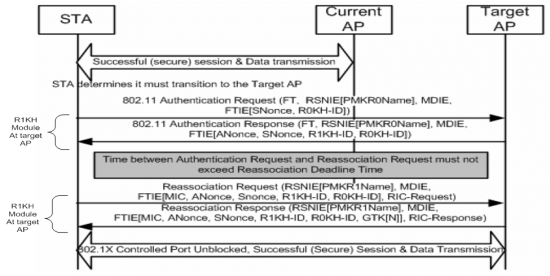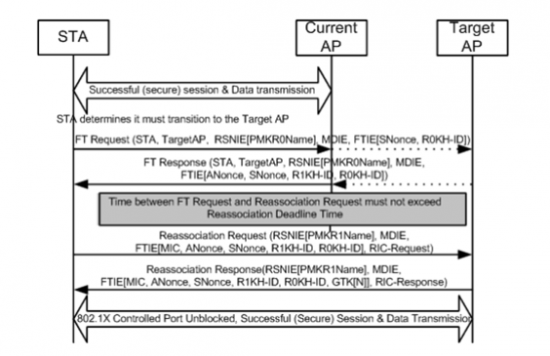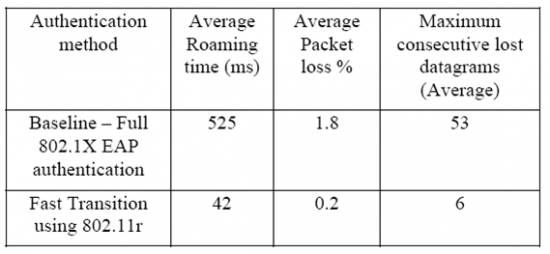In this short series of blogs, we’re spending some time looking at the lesser known but undeservedly underappreciated amendments to 802.11 and the features/benefits they provide.
The first blog explained the basics of 802.11k “WLAN Radio Measurements” and specifically zoomed in on the Neighbor Request/Report.
This blog will focus on the 802.11r amendment.
Fast BSS Transition (802.11r)
Fast BSS Transition (often abbreviated to Fast Transition or FT) describes mechanisms by which a mobile device can reestablish existing security and/or QoS parameters prior to reassociating to a new AP. These mechanisms are referred to as “fast” because they seek to significantly reduce the length of time that connectivity is interrupted between a mobile device and Wi-Fi infrastructure when that mobile device is connecting to a new AP. Please note that the process of disconnecting from one AP and connecting to another AP is formally designated as a “BSS transition”. Therefore, the protocols established by FT apply to mobile device transitions between APs only within the same mobility domain and within the same ESS (ESS transition is out of scope for FT). Since both reassociation and reauthentication are time critical processes, removing time consuming message exchanges between the mobile device and the infrastructure help reduce interruption to high value services (e.g., voice and/or video) when transitioning from one AP to another especially in a strongly secure WLAN (i.e, one using 802.1x and EAP methods for authentication).
Because Fast BSS Transition reestablishes existing parameters, the protocols require that information be exchanged during the initial association (or at a subsequent reassociation) between the mobile device (formally referred to as the FT Originator (FTO)) and an AP. The initial exchange is referred to as the FT initial mobility domain association. Subsequent reassociations to APs within the same mobility domain are expected to utilize the FT protocols.
Two basic FT protocols are described:
- FT Protocol. This protocol is performed when a mobile devices transitions from one AP to another AP but does not require a resource request prior to its transition. The AP selected by the mobile device for reassociation is referred to as the “target AP”.
- FT Resource Request Protocol. This protocol is performed when a mobile device requires a resource request prior to its transition.
For a mobile device to transition from the AP it is currently associated with to a target AP, the FT protocol message exchanges are performed using one of two methods:
- Over-the-Air. The mobile device communicates directly with the target AP using IEEE 802.11 authentication with the FT authentication algorithm.
- Over-the-DS. The mobile device communicates with the target AP via the current AP. Communications between the mobile device and the target AP are encapsulated within FT Action frames between the mobile device and the current AP. Communications between the current AP and the target AP, occurs via a different encapsulation method. The current AP converts between the two encapsulation methods.

Over the Air message exchange (excerpted from IEEE 802.11-2012)

Over the DS message exchange (excerpted from IEEE 802.11-2012)
Benefits of Fast BSS Transition
As mentioned above, the primary benefit of 802.11r is to significantly reduce the length of time that connectivity is interrupted between a mobile device and Wi-Fi infrastructure when that mobile device is connecting to a new AP.
This is especially useful for real time interactive services (e.g., voice and video). In a strongly secured WLAN (i.e., one that uses 802.1x and EAP methods), but without 802.11r, the mobile device would need to go through a complete reauthentication after reassociating. This can cause a significant interruption to a media flow. But with 802.11r, the reauthentication is effectively performed prior to reassociation (effectively establishing a “make before break” as opposed to “break before make”).

Above excerpted from: “Performance Study of Fast BS Transition using IEEE 802.11r” by Sangeetha Bangolae, Carol Bell and Emily Qi
Above excerpted from: “Performance Study of Fast BS Transition using IEEE 802.11r” by Sangeetha Bangolae, Carol Bell and Emily Qi Above excerpted from: “Performance Study of Fast BS Transition using IEEE 802.11r” by Sangeetha Bangolae, Carol Bell and Emily Qi
Above excerpted from: “Performance Study of Fast BS Transition using IEEE 802.11r” by Sangeetha Bangolae, Carol Bell and Emily Qi
The additional benefit is that without reauthentication, far less traffic is generated between the WLAN and the AAA authentication server. This improves both the scalability and reliability of the link between the WLAN and authentication server.
Better Together: 11k Neighbor Report and 11r Fast BSS Transition
As discussed in the previous blog The “Neighbor Report” request for 802.11k is sent from a client to an AP. The AP returns a “Neighbor Report” report containing information about neighboring APs that are known candidates for the client to reassociate with (should the client choose to do so). Therefore, the Neighbor Report request/report pair enables the client to collect information about the neighboring APs of the AP it is currently associated to and this information may be used as identification of potential candidates for a new point of attachment while roaming.
This is important for 11r because this list identifies the candidates for “target APs”.
Cisco support for Fast BSS Transition
Cisco WLAN infrastructure has supported 11r since release 7.2.110.
Fast BSS Transition has also been a fundamental feature in our VoWi-Fi solution and is further testimony as to Cisco’s pioneering work in making WLAN reliable for all types of IP traffic.
Cisco believes that 802.11r should be used in high density deployments where “roaming” between APs is frequent. This will result in a superior user experience.
Of course this means that mobile device vendors need to adopt Fast BSS Transition. But Cisco sees this as an increasing trend and we’re expecting to see this feature continue to proliferate in the industry with VoWi-Fi.


CONNECT WITH US